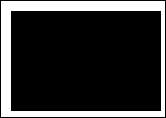Having some preliminaries out of the way, let's now examine the various SVG shapes that we will commonly use through the book. We have already seen how to create a circle; now let's look at some other shapes.
A circle is a special case of an ellipse that has an identical x and y radii. Ellipses can and often have different size radii. An ellipse is specified in SVG using the <ellipse> tag. We still use cx and cy attributes to position the ellipse, but instead of using r for radius, we use two attributes rx and ry to specify the radius in the x and y directions:
<ellipse cx="50" cy="30" rx="40" ry="20" />

Note
bl.ock (3.4): http://goo.gl/05QCnG
Rectangles are specified using the <rect> tag. The upper-left corner is specified using the x and y attributes. The width and height attributes specify those respective sizes for the rectangle:
<rect x="10" y="10" width="150" height="100"></rect>

Note
bl.ock (3.5): http://goo.gl...



